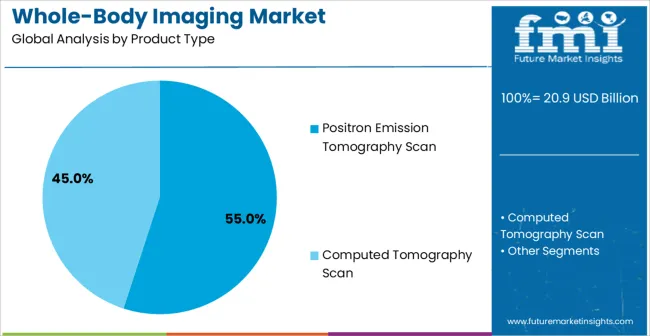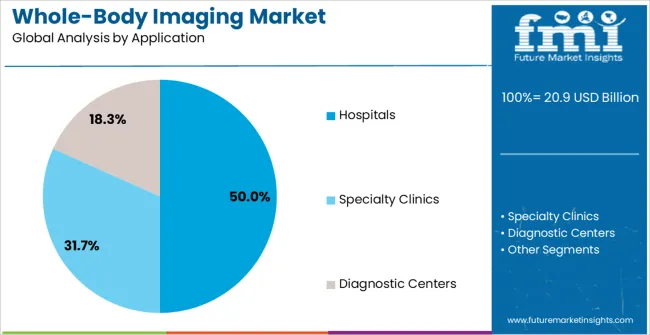The Whole-Body Imaging Market is estimated to be valued at USD 20.9 billion in 2025 and is projected to reach USD 38.5 billion by 2035, registering a compound annual growth rate (CAGR) of 6.3% over the forecast period.

| Metric | Value |
|---|---|
| Whole-Body Imaging Market Estimated Value in (2025 E) | USD 20.9 billion |
| Whole-Body Imaging Market Forecast Value in (2035 F) | USD 38.5 billion |
| Forecast CAGR (2025 to 2035) | 6.3% |
The Whole-Body Imaging market is experiencing steady growth, driven by the increasing demand for advanced diagnostic imaging technologies in both developed and emerging markets. The market is expected to see continued expansion due to the rising prevalence of chronic diseases and cancer, along with the growing focus on early diagnosis and precision medicine.
Technological advancements, particularly in Positron Emission Tomography (PET) and magnetic resonance imaging (MRI), have improved the accuracy, resolution, and speed of imaging, further driving adoption. Additionally, healthcare infrastructure improvements, along with an aging global population, are fueling demand for comprehensive diagnostic solutions.
The trend toward personalized treatment plans and the integration of artificial intelligence in imaging technologies are also expected to boost market growth As awareness of the benefits of early disease detection increases, the Whole-Body Imaging market is poised for robust growth, with expanding applications in hospitals, research institutions, and diagnostic centers.
The whole-body imaging market is segmented by product type, application, and geographic regions. By product type, whole-body imaging market is divided into Positron Emission Tomography Scan and Computed Tomography Scan. In terms of application, whole-body imaging market is classified into Hospitals, Specialty Clinics, and Diagnostic Centers. Regionally, the whole-body imaging industry is classified into North America, Latin America, Western Europe, Eastern Europe, Balkan & Baltic Countries, Russia & Belarus, Central Asia, East Asia, South Asia & Pacific, and the Middle East & Africa.

The Positron Emission Tomography (PET) scan segment is projected to hold 55.00% of the Whole-Body Imaging market revenue share in 2025, establishing it as the leading product type. This growth is attributed to the high diagnostic accuracy and ability to detect diseases at early stages, particularly cancers, cardiovascular diseases, and neurological disorders.
PET scans offer the advantage of capturing real-time metabolic processes, allowing for more comprehensive and precise diagnoses compared to traditional imaging methods. The increasing preference for non-invasive diagnostic techniques and the ability to monitor treatment responses further drive the adoption of PET scans in clinical settings.
As healthcare providers focus on improving patient outcomes through early detection, PET scans have become a cornerstone in modern diagnostic imaging Moreover, the growing number of hospitals and research centers adopting advanced imaging technologies supports the continued dominance of this segment.

The hospitals end-use segment is expected to capture 50.00% of the Whole-Body Imaging market revenue share in 2025, making it a key driver of market growth. Hospitals represent a significant portion of the healthcare sector, where advanced imaging systems, including whole-body imaging technologies, are essential for accurate diagnostics, treatment planning, and monitoring.
The growing number of hospital-based diagnostic centers and an increasing shift toward personalized medicine have contributed to the rise in demand for sophisticated imaging techniques. Hospitals require high-throughput imaging systems that can handle large volumes of patients while providing precise diagnostic information.
The integration of artificial intelligence into imaging workflows, which enhances the speed and accuracy of diagnoses, has further fueled the adoption of whole-body imaging in hospitals Additionally, the rising prevalence of chronic conditions and cancer is creating a sustained need for advanced diagnostic tools in hospital settings, ensuring continued growth for this segment.
Whole-body imaging refers to Magnetic Resonance Imaging (MRI) or full-body CT scan in the healthcare sector. It is considered to be an effective and quick modality to detect a particular disease in an individual’s body.
These imaging systems are capable of broadening the scope of vision in terms of the biological function of the body. These also help in tracking the immune system’s cellular activities in real-time.
These can enhance the ability of healthcare professionals to detect a metastatic spread, carotid, as well as peripheral vascular disease. These utilize computed tomography to generate elaborate, cross-sectional, and thin X-ray images. These images further allow doctors to examine a particular area of the patient’s body, such as the lungs or heart.
The rapid improvement in PET and CT scans is expected to boost the development of accurate and safe procedures that can be used in emergency cases. The introduction of portable devices, surging dependency on computing power, and enhancements in detector systems are likely to propel the market. In addition to this, the miniaturization of electronics is anticipated to spur the sales of whole-body imaging systems.

| Country | CAGR |
|---|---|
| China | 8.5% |
| India | 7.9% |
| Germany | 7.2% |
| Brazil | 6.6% |
| USA | 6.0% |
| UK | 5.4% |
| Japan | 4.7% |
The Whole-Body Imaging Market is expected to register a CAGR of 6.3% during the forecast period, exhibiting varied country level momentum. China leads with the highest CAGR of 8.5%, followed by India at 7.9%. Developed markets such as Germany, France, and the UK continue to expand steadily, while the USA is likely to grow at consistent rates. Japan posts the lowest CAGR at 4.7%, yet still underscores a broadly positive trajectory for the global Whole-Body Imaging Market. In 2024, Germany held a dominant revenue in the Western Europe market and is expected to grow with a CAGR of 7.2%. The USA Whole-Body Imaging Market is estimated to be valued at USD 7.4 billion in 2025 and is anticipated to reach a valuation of USD 7.4 billion by 2035. Sales are projected to rise at a CAGR of 0.0% over the forecast period between 2025 and 2035. While Japan and South Korea markets are estimated to be valued at USD 1.1 billion and USD 574.5 million respectively in 2025.

| Item | Value |
|---|---|
| Quantitative Units | USD 20.9 Billion |
| Product Type | Positron Emission Tomography Scan and Computed Tomography Scan |
| Application | Hospitals, Specialty Clinics, and Diagnostic Centers |
| Regions Covered | North America, Europe, Asia-Pacific, Latin America, Middle East & Africa |
| Country Covered | United States, Canada, Germany, France, United Kingdom, China, Japan, India, Brazil, South Africa |
| Key Companies Profiled | Siemens Healthineers, GE Healthcare, Philips Healthcare, Canon Medical Systems, Hitachi Medical Corporation, Fujifilm Holdings, Samsung Medison, and Mindray Medical International |
The global whole-body imaging market is estimated to be valued at USD 20.9 billion in 2025.
The market size for the whole-body imaging market is projected to reach USD 38.5 billion by 2035.
The whole-body imaging market is expected to grow at a 6.3% CAGR between 2025 and 2035.
The key product types in whole-body imaging market are positron emission tomography scan and computed tomography scan.
In terms of application, hospitals segment to command 50.0% share in the whole-body imaging market in 2025.






Our Research Products

The "Full Research Suite" delivers actionable market intel, deep dives on markets or technologies, so clients act faster, cut risk, and unlock growth.

The Leaderboard benchmarks and ranks top vendors, classifying them as Established Leaders, Leading Challengers, or Disruptors & Challengers.

Locates where complements amplify value and substitutes erode it, forecasting net impact by horizon

We deliver granular, decision-grade intel: market sizing, 5-year forecasts, pricing, adoption, usage, revenue, and operational KPIs—plus competitor tracking, regulation, and value chains—across 60 countries broadly.

Spot the shifts before they hit your P&L. We track inflection points, adoption curves, pricing moves, and ecosystem plays to show where demand is heading, why it is changing, and what to do next across high-growth markets and disruptive tech

Real-time reads of user behavior. We track shifting priorities, perceptions of today’s and next-gen services, and provider experience, then pace how fast tech moves from trial to adoption, blending buyer, consumer, and channel inputs with social signals (#WhySwitch, #UX).

Partner with our analyst team to build a custom report designed around your business priorities. From analysing market trends to assessing competitors or crafting bespoke datasets, we tailor insights to your needs.
Supplier Intelligence
Discovery & Profiling
Capacity & Footprint
Performance & Risk
Compliance & Governance
Commercial Readiness
Who Supplies Whom
Scorecards & Shortlists
Playbooks & Docs
Category Intelligence
Definition & Scope
Demand & Use Cases
Cost Drivers
Market Structure
Supply Chain Map
Trade & Policy
Operating Norms
Deliverables
Buyer Intelligence
Account Basics
Spend & Scope
Procurement Model
Vendor Requirements
Terms & Policies
Entry Strategy
Pain Points & Triggers
Outputs
Pricing Analysis
Benchmarks
Trends
Should-Cost
Indexation
Landed Cost
Commercial Terms
Deliverables
Brand Analysis
Positioning & Value Prop
Share & Presence
Customer Evidence
Go-to-Market
Digital & Reputation
Compliance & Trust
KPIs & Gaps
Outputs
Full Research Suite comprises of:
Market outlook & trends analysis
Interviews & case studies
Strategic recommendations
Vendor profiles & capabilities analysis
5-year forecasts
8 regions and 60+ country-level data splits
Market segment data splits
12 months of continuous data updates
DELIVERED AS:
PDF EXCEL ONLINE
Imaging Markers Market Analysis - Size, Share, and Forecast Outlook 2025 to 2035
3D Imaging Surgical Solution Market Size and Share Forecast Outlook 2025 to 2035
Gel Imaging Documentation Market Size and Share Forecast Outlook 2025 to 2035
PET Imaging Workflow Market Analysis - Size, Share, and Forecast Outlook 2025 to 2035
Brain Imaging and Neuroimaging Market Size and Share Forecast Outlook 2025 to 2035
Dental Imaging Equipment Market Forecast and Outlook 2025 to 2035
Remote Imaging Collaboration Market Analysis - Size, Share, and Forecast Outlook 2025 to 2035
Competitive Overview of Aerial Imaging Market Share
Aerial Imaging Market Growth - Trends & Forecast 2025 to 2035
Breast Imaging Market Analysis - Size, Share & Growth Forecast 2024 to 2034
Spinal Imaging Market Trends – Growth, Demand & Forecast 2022-2032
Hybrid Imaging System Market
Optical Imaging Market Size and Share Forecast Outlook 2025 to 2035
Quantum Imaging Devices Market Analysis - Size, Share, and Forecast Outlook 2025 to 2035
Medical Imaging Software Market Size and Share Forecast Outlook 2025 to 2035
Nuclear Imaging Devices Market Size and Share Forecast Outlook 2025 to 2035
Urology Imaging Systems Market Size and Share Forecast Outlook 2025 to 2035
In Vivo Imaging Systems Market Size and Share Forecast Outlook 2025 to 2035
Global Nuclear Imaging Equipment Market Insights – Trends & Forecast 2024-2034
Medical Imaging Agent-Producing System Market

Thank you!
You will receive an email from our Business Development Manager. Please be sure to check your SPAM/JUNK folder too.
Chat With
MaRIA